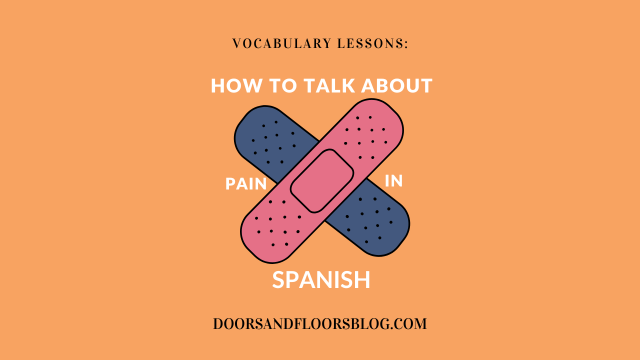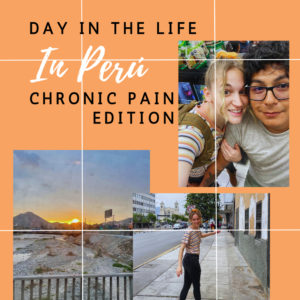
Talking about pain can be difficult enough in English, but what happens when you’re visiting a foreign country, learning another language, or have a new family that only speaks Spanish? What happens when you need to be able to communicate not in English in these situations?
Perhaps this isn’t something that is as common and every day for you as it is for me. But I feel like it’s still a good topic to discuss. For me personally, because I live in a country that speaks Spanish. I need to know how to ask for help in case of emergencies, and at least be able to describe something about the problem going on.
Travel

Perhaps a little more applicable to you, is travel.
If you do any traveling abroad knowing a least a couple sentences can be good to have on hand if you ever get into an unfavorable situation. Even if that unfavorable situation is a headache that just won’t go away.
In the USA you can buy ibuprofen in the grocery aisles, the same is not true in Perú. Here you’ll need to visit a little streetside pharmacy and describe your symptoms before they sell anything to you. I assume you may run into similar situations in other countries.
Learning how to ask for help in Spanish is essential when experiencing pain. Whether you need to see a doctor, find a pharmacy, or ask for pain medication, being able to communicate effectively in Spanish can make all the difference in getting the care you need. It’s important to remember that even if you’re not fluent in Spanish, being able to use basic vocabulary and phrases can still be extremely helpful in getting the assistance you need.
Another, non-emergency related reason to know how to talk about pain in Spanish, is if you ever visit a dentist, masseuse, or hair salon overseas. During one of these visits you may occasionally get asked if things hurt. It’s good to know at the least what the word is for “hurt” so that you can communicate your needs during your appointment.
Help In Spanish

There are different types of pain in the world, of course, and different feelings and sensations that happen when pain occurs. Today, I thought it would be a good idea to discuss a few of those descriptive words and to give you a couple of sentences that you can use these words in. In addition, perhaps we should first go over how to ask for help in Spanish.
We discussed how to ask for help a little more in-depth in our post 10 Spanish Questions and Phrases you need to know, so to be brief, to simply ask for help you would say: Ayudame! (Help!)
If you want to learn a few variations, head on over to our other post for a deeper talk on the subject!
Let’s Learn Some Vocabulary

You can use some of the following words to piece together a sentence about pain in Spanish should the need arise. Your sentences don’t have to be perfect, just enough to get the point across.
Try memorizing a few of the words below to keep on hand for emergencies. Hopefully, before the need ever arises, you will have learned even more Spanish by then.
- Dolor – Pain
- Agudo – Sharp
- Punzante – Stabbing
- Quemante – Burning
- Constante – Constant
- Intenso – Intense
- Insoportable – Unbearable
Pain In Spanish Sentences

Now that we know some basic vocabulary, I put together a few of sentences for you. I recommend picking one or two and memorizing the structure of the sentence.
- Me duele aquí – It hurts here
- Siento un dolor agudo – I feel a sharp pain
- El dolor es constante – The pain is constant
- Me duele cada vez que respiro – It hurts every time I breathe
- El dolor es insoportable – The pain is unbearable
- Siento un dolor punzante – I feel a stabbing pain
- El dolor es intenso – The pain is intense
- Me duele al moverme – It hurts when I move
In case of emergencies, my messy sentence is something like, “Ayudame! Duele aqui” while pointing to my pain point. Not at all pretty, but it will do enough to get me some help in my time of need.
I do however plan to do a little more practice and try to memorize words like these so I can form better sentences about my pain in Spanish. In less stressful situations I’m able to think clearer and better piece things together.
You should check out our post about Improving Beginner Spanish With 10 Easy Categories to expand your knowledge. This will help you be able to get a little more specific about what hurts in your sentences, maybe your toes or your head. In that post, we go over a lot of things to really help you build your conversational Spanish.
Final Thoughts

Being able to talk about pain in Spanish can help you connect with Spanish-speaking friends or family members who may be experiencing pain. It helps you understand and empathize with others’ pain so you can better build relationships. Language should not be a barrier to that.
The more Spanish you know also helps make conversations about chronic pain easier to have!
Learning Spanish and being able to communicate effectively about pain can increase your confidence and independence. Being able to navigate a Spanish-speaking country with ease, without relying on others to translate for you, can be a powerful and empowering experience.
Interested in learning more Spanish or about chronic pain? Check out these posts!
- The Beginner’s Guide To Fibromyalgia
- How To Reimagine Diet Restrictions In A Foreign Country
- 12 Ways To Improve Your Language Learning – Without An App
Also, if you’re looking for an activity you can do on a bad flare day and from bed, download our free trivia here so that you can still participate in fun activities with your friends and family without ever leaving the comfort of your bed.
Let me know in the comments if you found this post helpful! And let’s chat, what other Spanish tips are you interested in learning about?







